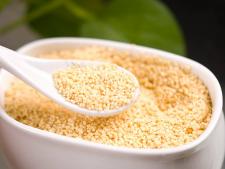-

lecithin
| Food | Percentage of DRI per 100 grams | |
|---|---|---|
Lecithin is a fatty acid that is essential in the cells of the body. It occurs naturally in the structure of all cell membranes and is needed by every living cell in the human body as well as animals and plants.
For culinary purposes lecithin extracted from from soybeans or sunflower seeds is available in the form of liquid, powder or granules. The lipids in lecithin have both hydrophilic and hydrophobic parts, meaning they are able to attract both water and oil, making lecithin a a very useful culinary ingredient for making emulsions. This means It helps bind water based ingredients such as vinegar to fat based ingredients such as oil. It is used frequently in products such as mayonnaise, creamy sauces, and dressings. Lecithin is also a stabilizer, which means it helps suspend emulsification, preventing them from separating. If your vinaigrette doesn´t contain lecithin, the vinegar will sink to the bottom and a layer of oil will accumulate on top. This might mean that some diners will get an oily salad while others will get a salad that tastes only of vinegar.
Lecithin also has the ability to capture and lock in moisture, preventing baked goods from drying out, giving them a longer shelf life. It is also often added to chocolate to give it a smooth mouthfeel and to prevent sugar crystallization. Lecithin is also useful in eggless baking, to replace the naturally occurring lecithin in egg yolks. And, it is also useful ingredient when making culinary foams, because of its ability to delay collapse, stabilizing the foam, and supporting bubbles to maintain their structure longer.
Lecithin has a neutral flavor and color, so it works well in both sweet and savory recipes.
VOLUME
Very quiet
HOW TO USE
Use ans an Emulsifier, thickener and stabilizer.
If the majority of what you are making is fat – use liquid lecithin. Such as vegan butter, oil based dressings, mayonnaise. Mix it into your fat before making the recipe. If the majority is water - use powdered lecithin.
The granules can be difficult to dissolve so may need to blend on high or to soften in warm liquid.
Egg yolk replacement: Dissolve 1 ½ tablespoons of lecithin granules in 2 teaspoons of liquid for each egg yolk called for in a recipe. Of course take into account that lecithin won´t provide the same flavor, binding, richness or leavening effects that you will get from an egg yolk.
Baking: Measure 10 grams of lecithin powder for every 100 grams flour
SELECTING
Lecithin is not a raw product. Most often it is made with soy. But it can also be made with sunflower or corn. Beware, sometimes fats from dairy or animals such as fish is used, so look for certified vegan alternatives. And if it is made with soy or corn chances are it is genetically modified. Look for guaranteed GMO-free, preferably sunflower lecithin. The granules are more difficult to disperse. The powder dissolves very easily. And of course the liquid dissolves automatically.
STORING
Lecithin will absorb moisture from the air, so once it´s open, make sure you seal it properly and store it in a cool, dark and dry place up to 6 months. Because lecithin is a processed product it doesn´t have the protection of antioxidants, which means it can easily become rancid. For longer shelf life store Lecithin in the refrigerator or freezer. It can last up to two years in the fridge and even longer in the freezer.
SUBSTITUTIONS
What to use when substituting lecithin will depend on the recipe and what reason the it calls for lecithin. For thickening? In certain recipes you can use potato starch or tapioca flour instead of lecithin. For thickening a nut milk, try Irish moss. As an emulsifier? Xanthan gum can be a replacement. Agar is another possibility.
HEALTH BENEFITS
Proponents of lecithin say it is an important dietary source of choline, which is used to transmit information between nerve cells and muscles. Choline is not produced by the body; most of it is obtained from the foods we eat. Choline is otherwise found in egg yolks and bee pollen, and rare to find in a vegan diet. Studies show that choline can support cognitive heath, improving memory and brain function, and can help people with Alzheimer´s and other neuorlogical disorders.
Another well-known health benefit of lecithin is its ability to lower LDL cholesterol and blood pressure, which in turn improves cardiovascular health. This is because it bind fats and cholesterol to water so they can be expelled from the body. Lecithin has also shown to support the liver and kidneys and help the body absorb minerals and vitamins.
Sceptics of lecithin, however, warn it´s a highly processed food, using a chemical solvent (usually hexane) in the extraction process, and then bleaching it with hydrogen peroxide.
And some people are concerned with soy products in particular, because they are often GMO contaminated. And another reason soy has caused concern is because it is the greatest food source of phytoestrogens which has been linked to testicular cancer, infertility, reduced sperm count and premature puberty in males.
Sunflower Lecithin on the other hand does not require harsh chemicals in the extraction process. Considering that it is non GMO and does not contain phytoestrogens it is quite strange that it is not more commonly used.